Birds of the Adirondacks:
Blackburnian Warbler (Setophaga fusca)
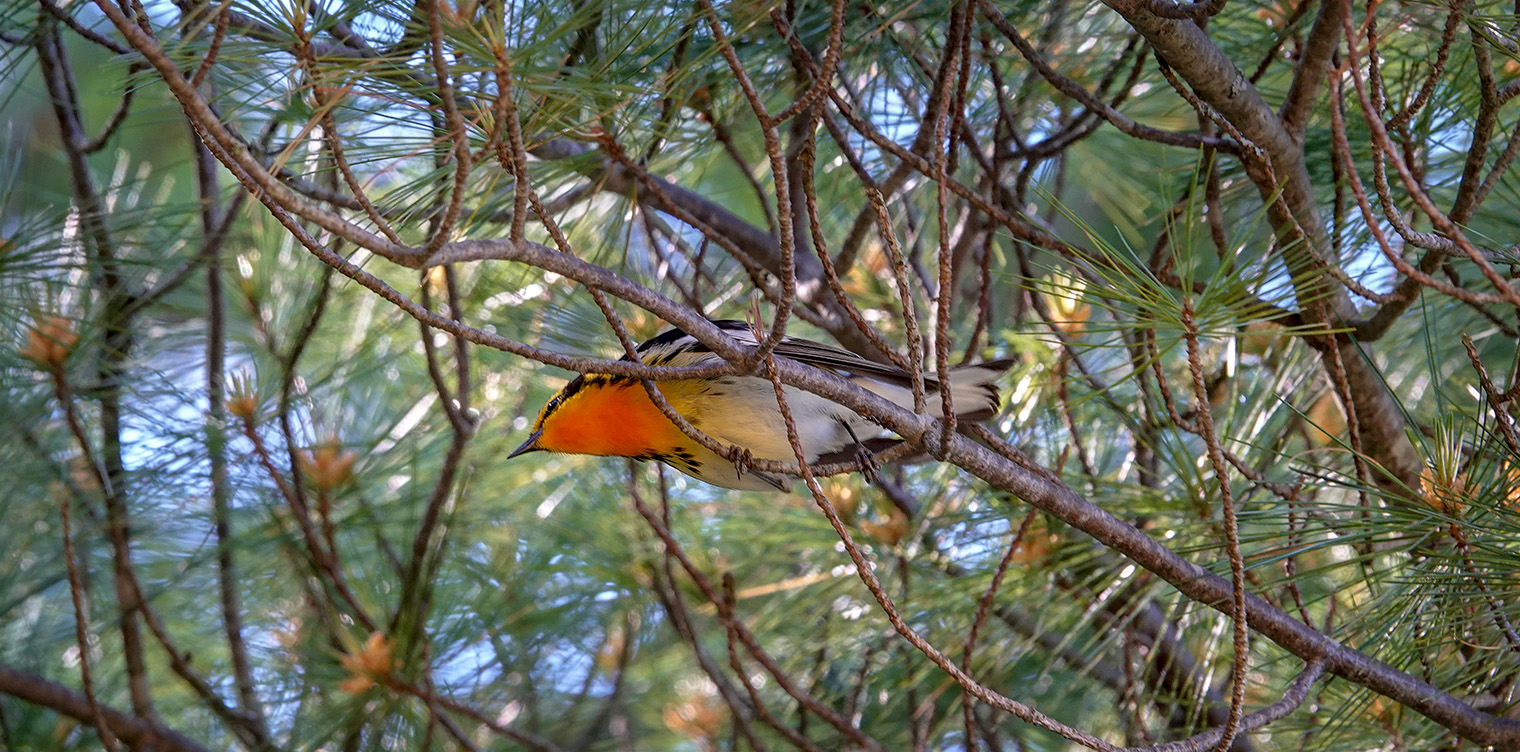
The Blackburnian Warbler (Setophaga fusca) is a small songbird that breeds in mature conifer and mixed forests. Male Blackburnian Warblers in breeding plumage are the only warblers in the Adirondacks sporting a bright orange throat with contrasting black markings.
The Blackburnian Warbler is a member of the New World Warbler or Wood Warbler family (Parulidae). Wood warblers subsist mainly on insects during breeding season and are primarily foliage gleaners, with slender, pointed bills. There are about 120 species in the wood warbler family, currently divided into 18 genera. The Second Atlas of Breeding Birds in New York State (2008) lists 33 warbler species (plus one hybrid) that breed in New York State; 29 are listed as possible, probable, or confirmed breeding birds in the Adirondack Park. All are migratory. Most arrive in the Adirondack Mountains in late April or early May and depart in September or October.
- The Blackburnian Warbler is currently assigned to the Setophaga genus, a large group which includes many other warblers that breed in the Adirondacks, including the Palm Warbler, Cape May Warbler, Northern Parula, Magnolia Warbler, Black-throated Blue Warbler, Black-throated Green Warbler, Yellow-rumped Warbler, Pine Warbler, Blackpoll Warbler, and Yellow Warbler. The name Setophaga is derived from the Greek ses ("moth") and phagos ("eating").
- The Blackburnian Warbler was previously assigned to the Dendroica genus. In 2011, as part of a larger rearrangement of Wood Warbler taxonomy, based on DNA studies, the Dendroica genus was merged with the Setophaga genus, which now contains at least 33 species. Older publications list the Blackburnian Warbler as Dendroica fusca.
- The species name (fusca) means dark or black, an apparent reference to the black markings on breeding males.
The nonscientific name – Blackburnian Warbler – is said to refer to an English woman, Anne Blackburne, a patron of ornithology who collected stuffed birds and was sent a specimen from New York in the late eighteenth century. Other nonscientific names for this species include Firethroat and Torchbird (references to the bright orange markings of the breeding male) and Hemlock Warbler (a reference to one of its favorite nesting sites).
Blackburnian Warbler: Identification
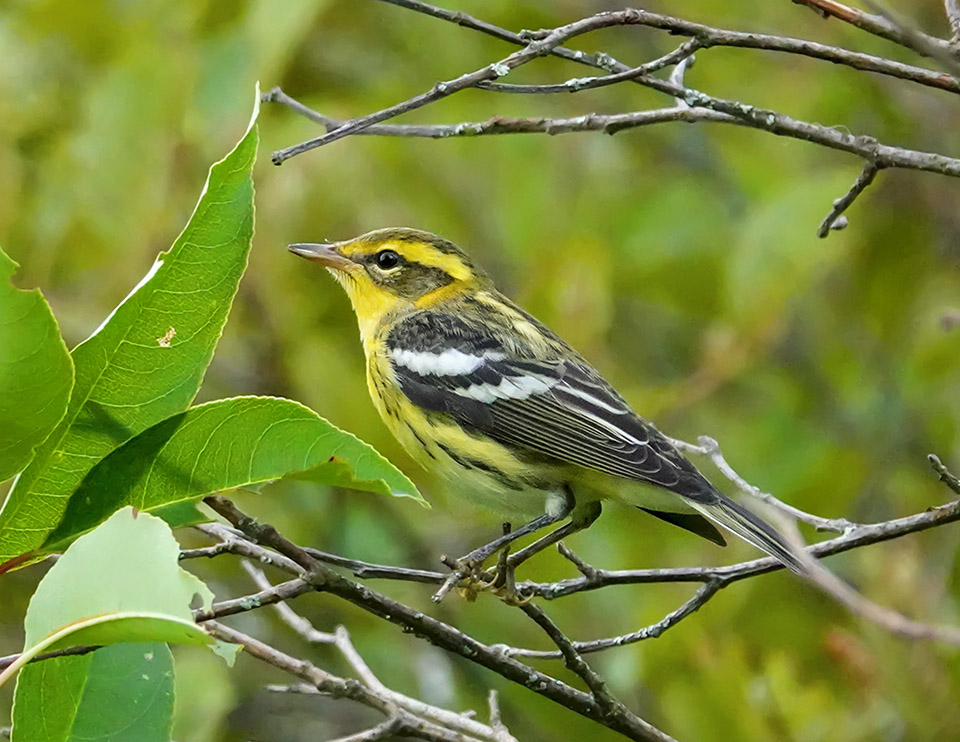
Blackburnian Warblers are small songbirds; they are about 4¾ to 5 inches in length from the tip of the beak to the tip of the tail. However, compared to other warblers, they are medium-sized, larger than the tiny Northern Parula (at 4¼ inches in length) but significantly smaller than the Louisiana Waterthrush (at 6 inches in length). Blackburnian Warblers are large-headed, with thick necks.
Blackburnian Warblers in all plumages have dark, triangular cheek patches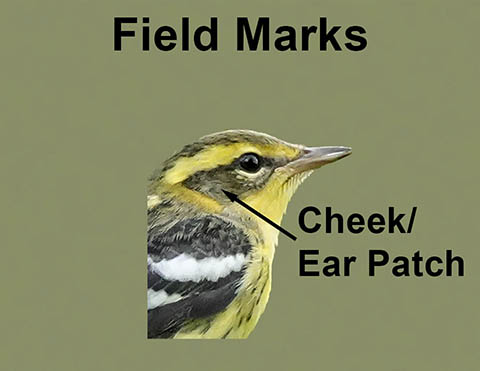 Cheek/Ear Patch: An area on the bird's head below and behind the eye.. The triangular shape of this patch is diagnostic. This warbler has an eyebrow
Cheek/Ear Patch: An area on the bird's head below and behind the eye.. The triangular shape of this patch is diagnostic. This warbler has an eyebrow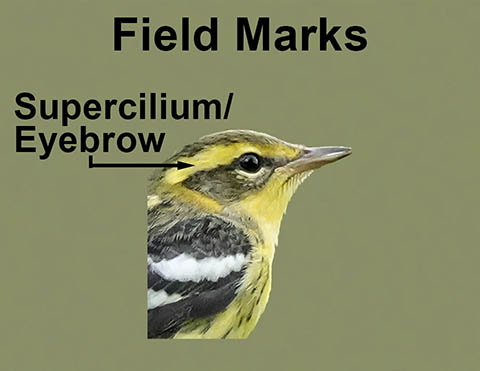 Supercilium/Eyebrow: The area of contrast above the bird's eye. (also called a supercilium) that connects around the ear patch to color on the sides of the neck. Blackburnian Warblers in all plumages also have wing bars/patches and a pair of pale lines (sometimes referred to as braces) running down a darker back.
Supercilium/Eyebrow: The area of contrast above the bird's eye. (also called a supercilium) that connects around the ear patch to color on the sides of the neck. Blackburnian Warblers in all plumages also have wing bars/patches and a pair of pale lines (sometimes referred to as braces) running down a darker back.
Male Blackburnian Warblers in breeding plumage have a brilliant orange throat and face with black triangular ear patches Cheek/Ear Patch: An area on the bird's head below and behind the eye.. The throat fades to pale yellow on the belly and sides. The eyebrow (supercilium
Cheek/Ear Patch: An area on the bird's head below and behind the eye.. The throat fades to pale yellow on the belly and sides. The eyebrow (supercilium Supercilium/Eyebrow: The area of contrast above the bird's eye.) is paler orange. Blackburnian males have an orange eye crescent
Supercilium/Eyebrow: The area of contrast above the bird's eye.) is paler orange. Blackburnian males have an orange eye crescent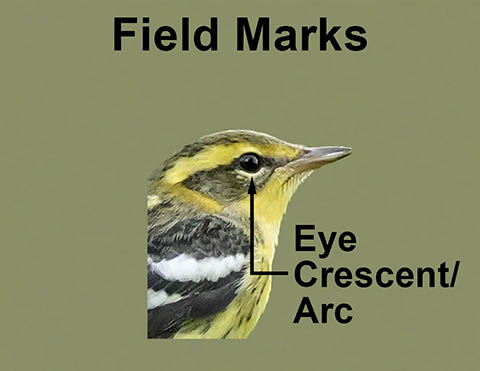 Eye Crescent/Arc: A partial ring around the eye of the bird. A complete ring around the eye is called an eye ring.. The crown
Eye Crescent/Arc: A partial ring around the eye of the bird. A complete ring around the eye is called an eye ring.. The crown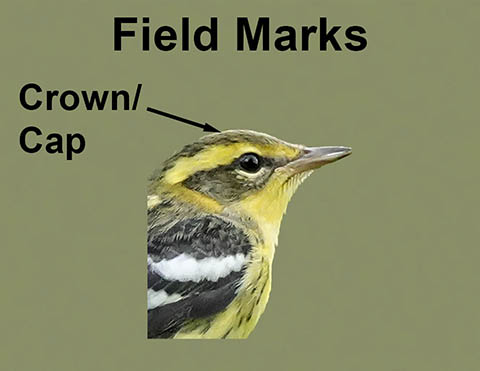 Crown/cap: The top of a bird's head. Some birds have a central crown stripe. is black with a contrasting orange streak on the forehead. Breeding males have a bright white mid-wing panel and white streaks on the back. There are fine black streaks on the sides to the flank
Crown/cap: The top of a bird's head. Some birds have a central crown stripe. is black with a contrasting orange streak on the forehead. Breeding males have a bright white mid-wing panel and white streaks on the back. There are fine black streaks on the sides to the flank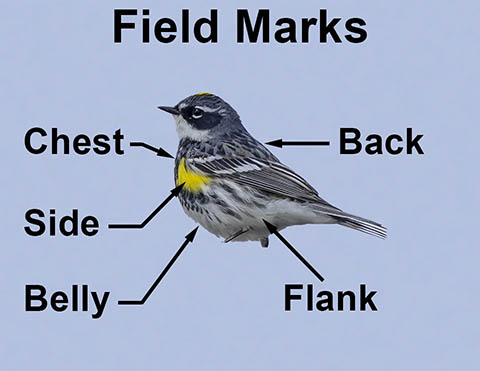 Flank: The lateral area posterior to the side region, lying below the pelvis and extending back to the base of the tail.. The undertail coverts
Flank: The lateral area posterior to the side region, lying below the pelvis and extending back to the base of the tail.. The undertail coverts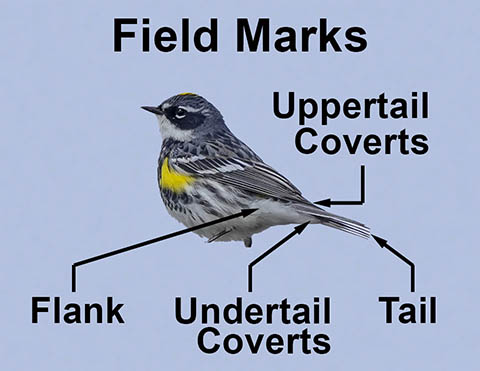 Undertail Coverts: The short feathers beneath the tail. are white.
Undertail Coverts: The short feathers beneath the tail. are white.
Adult female Blackburnian Warblers in breeding plumage are a paler and yellower version of their male counterparts. They are orange-yellow, rather than the bright orange of the males; and the markings are less distinct. The triangular cheek patch Cheek/Ear Patch: An area on the bird's head below and behind the eye. is charcoal or gray, rather than black. Females have wing bars, rather than the mid-wing panels of the breeding males. Both the belly
Cheek/Ear Patch: An area on the bird's head below and behind the eye. is charcoal or gray, rather than black. Females have wing bars, rather than the mid-wing panels of the breeding males. Both the belly Belly: The topographical region of a bird's underparts between the posterior end of the breast and the vent. and undertail coverts
Belly: The topographical region of a bird's underparts between the posterior end of the breast and the vent. and undertail coverts Undertail Coverts: The short feathers beneath the tail. are white. Female Blackburnian Warblers in breeding plumage have streaking on the back, as well as a pale line (sometimes referred to as suspenders).
Undertail Coverts: The short feathers beneath the tail. are white. Female Blackburnian Warblers in breeding plumage have streaking on the back, as well as a pale line (sometimes referred to as suspenders).
Immature Blackburnian Warblers have tones of yellow instead of orange. They have the distinctive triangular cheek patch Cheek/Ear Patch: An area on the bird's head below and behind the eye., pale eyebrow
Cheek/Ear Patch: An area on the bird's head below and behind the eye., pale eyebrow Supercilium/Eyebrow: The area of contrast above the bird's eye., white wing bars, and pale streak on the back of the adult Blackburnian. The crown
Supercilium/Eyebrow: The area of contrast above the bird's eye., white wing bars, and pale streak on the back of the adult Blackburnian. The crown Crown/cap: The top of a bird's head. Some birds have a central crown stripe. , cheek, and upper parts are brownish-olive. The juvenile's belly
Crown/cap: The top of a bird's head. Some birds have a central crown stripe. , cheek, and upper parts are brownish-olive. The juvenile's belly Belly: The topographical region of a bird's underparts between the posterior end of the breast and the vent. and undertail coverts
Belly: The topographical region of a bird's underparts between the posterior end of the breast and the vent. and undertail coverts Undertail Coverts: The short feathers beneath the tail. are white. The first fall male is similar to the adult female, while the first fall female is the palest yellow of all.
Undertail Coverts: The short feathers beneath the tail. are white. The first fall male is similar to the adult female, while the first fall female is the palest yellow of all.
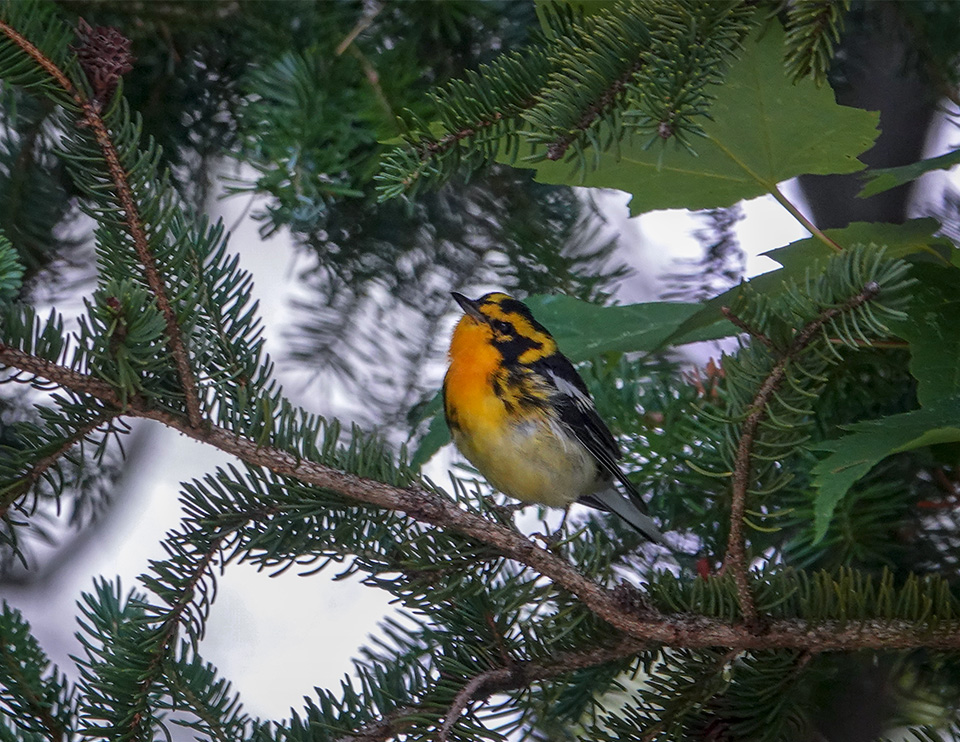
There are several other birds which breed in the Adirondack Park that are somewhat similar in coloring to the Blackburnian Warbler.
- The male American Redstart is black with bright orange patches on the sides, wings, and tail. The color pattern, however, is very different. American Redstarts have a black throat and breast, in contrast to the orange of the male Blackburnian Warbler. The American Redstart's face is plain black; and its wing patches are bright orange, rather than white.
- Nonbreeding and immature Palm Warblers have a rufous brown back and streaking in the center of the breast, rather than the flanks. The Palm's wing bars are fainter and buffy (rather than white); and the Palm Warbler's undertail coverts
 Undertail Coverts: The short feathers beneath the tail. are yellow (not white). Also, the Palm Warbler bobs its tail constantly – a behavior not seen in the Blackburnian Warbler.
Undertail Coverts: The short feathers beneath the tail. are yellow (not white). Also, the Palm Warbler bobs its tail constantly – a behavior not seen in the Blackburnian Warbler. - The male Bay-breasted Warbler in breeding plumage has chestnut markings, in contrast to the brilliant orange markings of the male Blackburnian. The Bay-breasted Warbler also lacks the wide eyebrow
 Supercilium/Eyebrow: The area of contrast above the bird's eye. and pale back braces of the Blackburnian Warbler.
Supercilium/Eyebrow: The area of contrast above the bird's eye. and pale back braces of the Blackburnian Warbler. - The female Blackpoll Warbler, like the female and immature male Blackburnian, has two white wing bars, but the Blackpoll lacks the Blackburnian's wide eyebrow
 Supercilium/Eyebrow: The area of contrast above the bird's eye. (supercilium).The Blackpoll also lacks the Blackburnian's distinctive triangular cheek patches
Supercilium/Eyebrow: The area of contrast above the bird's eye. (supercilium).The Blackpoll also lacks the Blackburnian's distinctive triangular cheek patches Cheek/Ear Patch: An area on the bird's head below and behind the eye.. The Blackpoll Warbler's orange legs also sets it apart from the Blackburnian Warbler.
Cheek/Ear Patch: An area on the bird's head below and behind the eye.. The Blackpoll Warbler's orange legs also sets it apart from the Blackburnian Warbler. - Female and immature Cape May Warblers are similar to female/immature Blackburnian Warblers. However, Cape May warblers have a greenish-yellow rump. They also lack the bright, conspicuous eyebrow
 Supercilium/Eyebrow: The area of contrast above the bird's eye. of the Blackburnian Warbler. Although Cape May Warblers have wing bars, they are much fainter than those of the Blackburnian Warbler. In addition, the Cape May Warbler has streaking on the throat or central chest
Supercilium/Eyebrow: The area of contrast above the bird's eye. of the Blackburnian Warbler. Although Cape May Warblers have wing bars, they are much fainter than those of the Blackburnian Warbler. In addition, the Cape May Warbler has streaking on the throat or central chest Chest: The chest (also called the breast) is the upright part of the bird’s body between the throat and the abdomen. that the Blackburnian Warbler lacks.
Chest: The chest (also called the breast) is the upright part of the bird’s body between the throat and the abdomen. that the Blackburnian Warbler lacks.
Blackburnian Warbler: Songs and Calls
Male Blackburnian Warblers, like some other warbler species, have several different songs. Their songs are usually described as very thin, high, and wiry. Sources conflict on whether Blackburnians have two songs (sometimes referred to as Type A vs Type B or accented vs unaccented), or three or more songs. Sources also conflict on which songs are the most common and which songs are most common under what conditions.
In our area, male Blackburnian Warblers have essentially two songs. Both consist of two, distinct parts. One begins with a short series of high notes (usually three notes), followed by a lower-pitched series of four or five notes. The other begins low and ends high; the first part of the song is a series rapid two-part notes (usually five or six). This is followed by one or two very high notes, that many people say they cannot hear.
The high beginning/low ending song sounds somewhat similar to the song of the Golden-crowned Kinglet. The Kinglet's song also starts out with high notes, then descends and ends with a series of notes on a lower pitch. However, the high notes at the beginning of the Golden-crowned Kinglet's song ascend the scale and accelerate; this part of the song also lasts much longer (up to three seconds) than the corresponding part of the Blackburnian Warbler's song. Also, the lower-pitched ending of the Golden-crowned Kinglet's song is more complex than that of the Blackburnian Warbler, sometimes sounding like a musical warble.
Although Blackburnian Warblers reportedly may begin singing on their wintering grounds before migration, most sources agree that the majority of singing is done on breeding grounds, with the highest frequency of singing soon after arrival. During breeding season, male Blackburnian Warblers sing while stationary on perches high up on the treetops; singing peaks in the very early morning. Blackburnians also may sing while foraging in vegetation.
Blackburnian Warblers use several different kinds of call notes. Their daytime flight call, heard during migration, is a thin, high "tsip." The call note of nocturnal migrants is a high, short, sharp "tzip." On their breeding grounds, nesting Blackburnian Warblers reportedly have a high "tseet" call note, sometimes doubled.
Blackburnian Warbler: Behavior
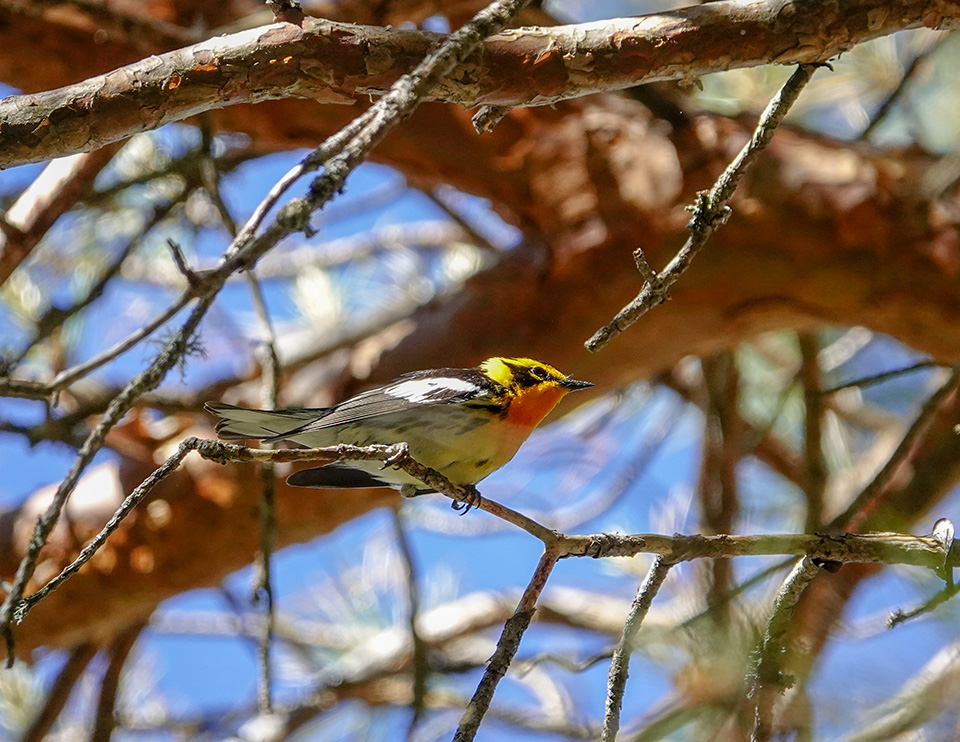
Blackburnian Warblers tend to stay high in the treetops. They move around by hopping on arboreal vegetation. Hopping is also used to get around during their infrequent visits to the ground. The Blackburnian's flight has been described as fast, direct, and slightly bouncy.
Blackburnian Warblers on their breeding grounds are territorial. They form territories shortly after arrival on their breeding grounds. Male Blackburnian Warblers defend their territories by aggressive displays that include bill snapping, wing flicking, and aerial encounters with competing birds.
Blackburnian Warblers generally consort only with their mates during the nesting period. After their offspring fledge, Blackburnians may be seen in mixed-species foraging flocks, sometimes with their young. Such flocks are usually led by the ubiquitous Black-capped Chickadees, whose chickadee-dee-dee calls serves as a useful marker for the possible presence of other species, including Blackburnian Warblers.
Both male and female Blackburnian Warblers frequently preen between bouts of foraging. Males preen at midday in exposed positions, often between periods of singing. During the middle of the day, males preen during periods of inactivity.
Blackburnian Warbler: Migration
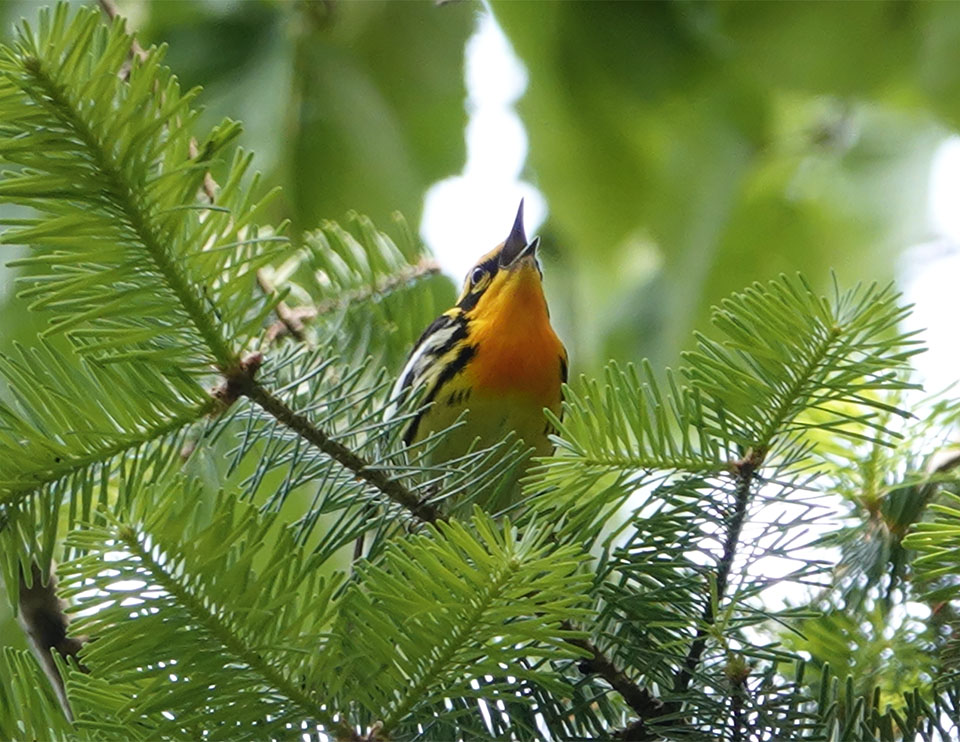
The Blackburnian Warbler is a Neotropical migrantNeotropical migrant/Neotropical migratory birds: Any species of bird whose breeding area includes the North American temperate zones and that migrates south of the continental United States during nonbreeding seasons. Neotropical migrant birds breed in North America during the spring and early summer and spend the winter in Mexico, the Caribbean, and Central and South America. , meaning that it winters south of the continental United States and migrates to North American temperate zones to breed in the spring and summer. The winter range of Blackburnian Warblers is mainly in southern Central America and northern South America.
Blackburnian Warblers are trans-Gulf migrants, meaning that they migrate across the Gulf of Mexico rather than around it. Trans-Gulf migrants fly across the Gulf of Mexico between the Yucatan Peninsula and the Gulf Coast from Texas to Florida.
The northbound spring migration begins in early April, later than early-spring migrants, such as Northern Parulas and Palm Warblers, but earlier than late migrants, such as the Mourning Warbler. Blackburnian Warblers reportedly appear in the southern US sometime in April, with males arriving a few days before the females.
The southbound fall migration begins during the first part of August, with most birds generally reaching their wintering grounds in September and October. The fall route is more easterly than that of spring. Birds that have spent the breeding season on the western edge of the breeding range tend to fly east before heading south in the fall. Fall migration is said to be spread out over a broader front than the spring migration.
Blackburnian Warblers are usually nocturnal migrants, with more limited daytime movement. During the initial period of the fall migration from the north, Blackburnians are often seen in mixed-species flocks with other warblers and full-time resident birds, such as Black-capped Chickadees. During migration, Blackburnian Warblers regularly use all woody habitats, including deciduous and coniferous forests, although they are said to prefer mature woodlands.
Migration patterns affecting the Blackburnian Warblers we see here in the Adirondack Mountains reflect these trends.
- In the Adirondack Park, Blackburnian Warblers appear to arrive starting in very late April; most appear in the first week or two of May. The pattern of eBird sightings in the six core Adirondack counties (Essex, Hamilton, Warren, Herkimer, Clinton, and Franklin) show the highest number of reports in the last week in May through the entire month of June and the first two weeks of July. Some of the May sightings probably reflect migrants headed further north.
- In the Adirondacks, Blackburnian Warblers apparently begin leaving breeding grounds in late summer and early fall. Estimating the departure period is difficult, because of the problem of disentangling reports which reflect birds which breed in the Adirondacks and those reflecting birds which are migrating through the area from Canada. In any event, it appears that most Blackburnians who breed in the Adirondacks probably leave here in the first three weeks of August. The last ten years showed an increased number of reports in the third week of August and the first week of September. This trend may be due to birds transiting our region from more northern breeding grounds in Canada. By the beginning of October, most Blackburnian Warblers appear to have left the Adirondack region, with a few stragglers reported in the third week of October.
Blackburnian Warbler: Diet and Foraging
As with other New World Warblers, Blackburnian Warblers feed primarily on insects on their breeding grounds. Their menu includes large quantities of caterpillars, including the larvae of spruce budworms. Also on the Blackburnian's breeding season menu are spiders, larval and adult flies, beetles, ants, aphids, and lacewings.
Like other warblers, Blackburnian Warblers are very active foragers, in constant motion while pursuing their prey.
- Like most warblers, Blackburnians are leaf gleaners, rather than bark gleaners (like Black-and-white Warblers or Red-breasted Nuthatches) or flycatchers (birds that fly out to catch flying insects, like American Redstarts).
- Blackburnian Warblers forage for their prey on both conifers and deciduous trees. In both conifers and deciduous vegetation, they tend to glean from small branches, feeding on the underside of vegetation mainly by hovering. Blackburnians often work their way outward along branches, starting at the base and moving to the tip.
- Also, Blackburnian Warblers forage mainly in the high and middle ranges of trees, rather than the shrub area near the ground (like Common Yellowthroats and Mourning Warblers) or the forest floor (like the Northern Waterthrush or the Hermit Thrush). Male Blackburnian Warblers tend to forage higher in the trees than their female counterparts.
During migration and on their wintering grounds, the Blackburnian Warbler is often found lower in the foliage. Their menu also changes; during winter they will often supplement their diet with berries.
Blackburnian Warbler: Breeding and Family Life
The breeding cycle for Blackburnian Warblers begins when the males (who arrive a few days earlier than their female counterparts) establish territories. Pair formation occurs soon after the female's arrival. Blackburnian Warblers are said to form seasonally monogamous pairs.
Nest building begins soon after pairing. Most observors agree that only the female builds the nest, which is cup-shaped and constructed of twigs, bark, and plant fibers, lined with lichens, mosses, and dead pine needles. Nests are usually well-concealed in dense vegetation. Blackburnians almost always place their nests in conifers, with a decided preference for hemlocks in most areas.
The female lays a clutch of three to five eggs, with the young hatching after about 12-13 days. Only the female broods. Both parents feed the nestlings. Blackburnian Warblers normally rear only one brood in a season, although the female may lay additional clutches if her nest is destroyed.
Fledglings are generally in close contact with their parents during the first few days after leaving the nest. They later begin loud begging calls while following their parents around, demanding food. The duration of the fledgling stage is unknown. Eventually, the fledged young leave their natal areas, with some joining mixed-species flocks of foraging birds (usually led by Black-capped Chickadees).
Distribution of the Blackburnian Warbler
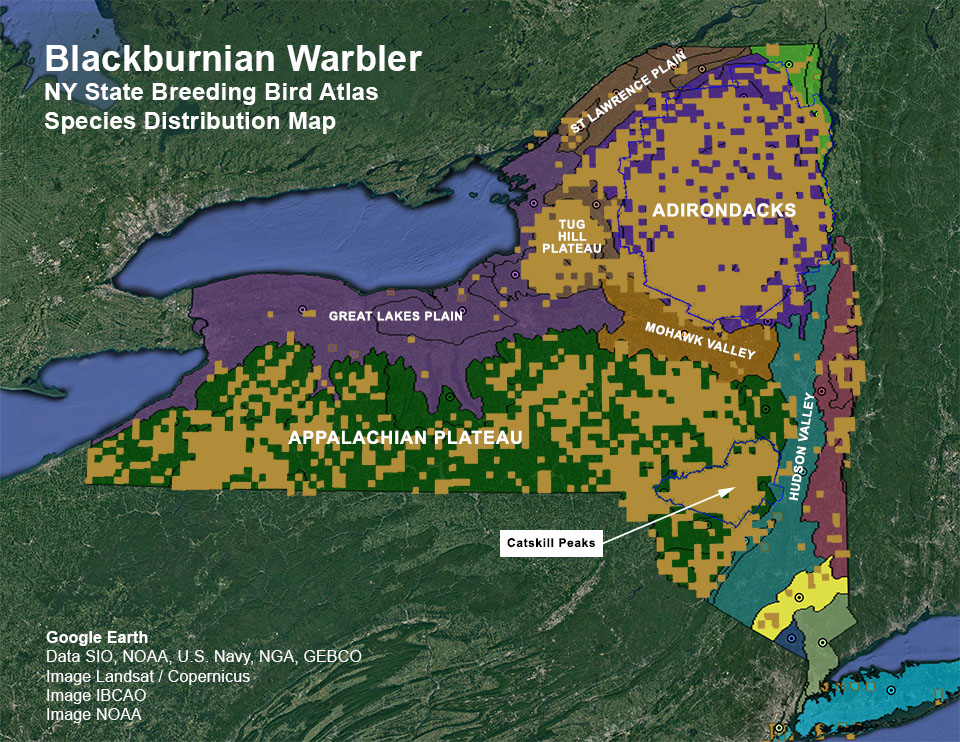
The breeding range of Blackburnian Warblers is in northeastern North America. Breeding Blackburnians are found west to central Alberta, north to central Saskatchewan, east to southern Quebec and the Maritime Provinces, and south to Massachusetts and New York. Blackburnian Warblers also breed in the Appalachian Mountains, south to Georgia. The highest densities of this species are in northeastern Minnesota, northern Wisconsin, central Ontario, and northern New York.
Blackburnian Warbler populations appear to be stable. Partners in Flight estimated a global population of 13 million, with 9.3 million in Canada and 4 million in the US. The North American Breeding Bird Survey found very slight increases in the population from 1966 to 2015 for the United States and Canada.
In New York State, Blackburnian Warblers breed mainly in the Adirondack Mountains, the Tug Hill Plateau, and Appalachian Plateau (particularly the eastern portions including the Catskills).
- In the 1980-1985 New York State Breeding Bird survey, most of the confirmed breeding sites were in the Adirondacks and Tug Hill Plateau, with additional confirmed sites in the Catskills and a few others in the southwestern portions of the Appalachian Plateau.
- The overall distribution of breeding Blackburnian Warblers did not change appreciably in the 2000-2005 New York State Breeding Bird Survey. The number of blocks with breeding records increased by 19 percent, although the number of blocks with confirmed breeders declined slightly (by 4%). Most of the increases in the number of blocks with probable breeding activity were found in in the Appalachian Plateau and Tug Hill Plateau.
- More recent trends in Blackburnian Warbler breeding activity will become clearer as data emerge from the third New York Breeding Bird Atlas, which began on 1 January 2020. This atlas, which covers 2020-2024, will use eBird for data collection, offering real-time data output.
The Partners in Flight Landbird Conservation Plan for the Adirondack Mountains indicated that Blackburnian Warbler populations in the Adirondacks have been stable.
The average life span for this species is not known. The oldest recorded Blackburnian Warbler on record was a minimum of eight years and two months old. Limited research has been done on the causes of mortality for individual Blackburnians. Nestlings may die of exposure or starvation during cold, rainy periods. Another cause of mortality is predation. Newly fledged Blackburnian Warblers may be taken by Red Squirrels or Blue Jays. Cooper's Hawks, Sharp-shinned Hawks, and Merlins reportedly prey on breeding adult Blackburnians. Many other Blackburnian Warblers perish during migration when they hit television towers and other objects.
Blackburnian Warbler: Breeding Habitat
The Blackburnian Warbler is characteristically associated with mature conifer forests (such as balsam flats and mountain spruce-fir forests) and mixed forests dominated by conifers, such as hemlock-northern hardwood forests and spruce flats. Blackburnian Warblers show a marked preference for old-growth stands that contain only conifers or mixed stands that include tall conifers such as Eastern Hemlock, White Spruce, Red Spruce, Eastern White Pine, and Balsam Fir, as well as deciduous trees such as American Beech, Sugar Maple, and Yellow Birch. Blackburnians reportedly avoid even-aged stands that lack emergent trees.
The Blackburnian Warbler's decided preference for mature forest is shown in a 1977 study of the response of songbird populations to logging. The study was conducted between 1953 and 1962 in the Huntington Wildlife Forest in the central Adirondacks. The researchers found that Blackburnian Warbler populations, like those of Ovenbirds and Black-throated Green Warblers, decreased significantly in response to logging activities. By contrast, warblers who thrive in early successional habitats and young forests, such as Chestnut-sided Warblers, Canada Warblers, and Black-and-white Warblers, showed population increases.
Where to find Blackburnian Warblers in the Adirondacks
Adirondack Birding Sites for Blackburnian Warblers
- High Peaks
- Marcy Dam
- Lyon Mountain
- Northville-Placid Trail (Long Lake)
- Northern Region
- Five Ponds Wilderness
- Saranac Lake Village
- West-Central Region
- Moose River Plains
- Wakely Mountain
- Third Lake Creek
- Ferd's Bog
- Woodhull Lake
- Wheeler Pond Loop
- Beaver Lake
Source: John M.C. Peterson and Gary N. Lee. Adirondack Birding. 60 Great Places to Find Birds (Lost Pond Press, 2008).
Adirondack birders in search of Blackburnian Warblers have a variety of birding sites to choose from, particularly in the west-central region, as listed in Peterson and Lee's Adirondack Birding guide. Their list of birding sites for Blackburnian Warblers includes the Moose River Plains; Wakely Mountain, Ferd's Bog, and the Wheeler Pond Loop in Hamilton County; Marcy Dam in Essex County; and Lyon Mountain in Clinton County.
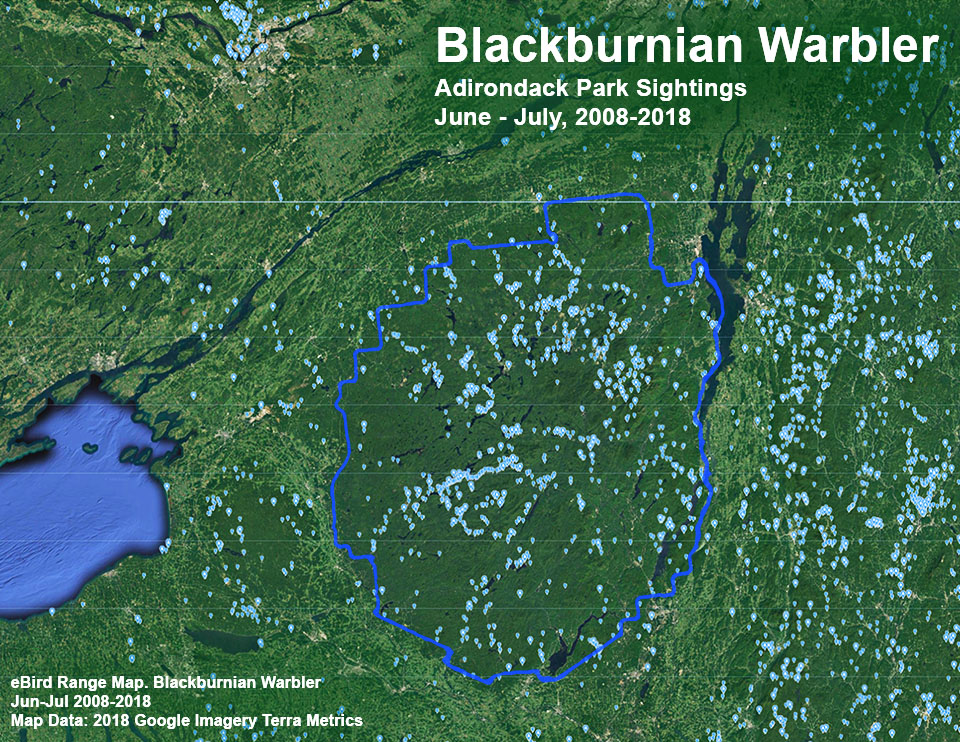
The pattern of eBird sightings for the Blackburnian Warbler during breeding season is roughly consistent with the Peterson/Lee recommendations and the findings of the two New York State Breeding Bird Surveys.
Consistent with the findings of the two breeding bird surveys, sightings of the Blackburnian Warbler reported through eBird are more numerous inside the Blue Line, despite the fact that there are more eBirders outside the Park. The sightings cluster in the Adirondack Park, Tug Hill Plateau, and Appalachian Plateau (south of the Finger Lakes).
Within the Adirondack park, the list of eBird reports for the Blackburnian Warbler includes clusters of sightings in popular birding sites, such as Spring Pond Bog Preserve, Silver Lake Bog Preserve, the Paul Smith's College VIC, Bloomingdale Bog (both the north and south entrances), Ferd's Bog, Moose River Plains, Whiteface Mountain Memorial Highway, Blue Mountain Road, Madawaska Pond, Amy's Park, and Massawepie Mire.
Among the trails covered here, the most likely locations to look for Blackburnian Warblers include the conifer-dominated wooded areas on the Ski Jump Trail at the John Brown Farm, any of the trails at the Paul Smith's College VIC that go through conifer or mature mixed forest, as well as areas with conifers along Hulls Falls Road and the Bloomingdale Bog Trail.
References
American Ornithological Society. Checklist of North American Birds. Setophaga. Retrieved 3 January 2020.
Avibase. The World Bird Database. Blackburnian Warbler. Setophaga fusca. Retrieved 3 January 2020.
.
Cornell Lab of Ornithology, Ithaca, New York. All About Birds. Blackburnian Warbler. Setophaga fusca. Retrieved 3 January 2020.
Cornell Lab of Ornithology, Ithaca, New York. Birds of the World. Subscription Web Site. Blackburnian Warbler. Setophaga fusca. Retrieved 27 March 2021.
Cornell Lab of Ornithology, Ithaca, New York. Macaulay Library. Blackburnian Warbler. Setophaga fusca. Retrieved 12 January 2019.
Cornell Lab of Ornithology, Ithaca, New York. eBird. An Online Database of Bird Distribution and Abundance. Bird Observations (Warren, Hamilton, Essex, Herkimer, Clinton, Franklin). Retrieved 27 March 2021.
Cornell Lab of Ornithology, Ithaca, New York. eBird. An Online Database of Bird Distribution and Abundance. Bird Observations (Hamilton).Retrieved 27 March 2021.
Cornell Lab of Ornithology, Ithaca, New York. eBird. An Online Database of Bird Distribution and Abundance. Bird Observations (Essex). Retrieved 27 March 2021. .
Cornell Lab of Ornithology, Ithaca, New York. eBird. An Online Database of Bird Distribution and Abundance. Bird Observations (Franklin). Retrieved 27 March 2021.
Cornell Lab of Ornithology, Ithaca, New York. eBird. An Online Database of Bird Distribution and Abundance. Bird Observations (Hamilton, Essex, Franklin). Retrieved 27 March 2021.
Cornell Lab of Ornithology, Ithaca, New York. eBird. An Online Database of Bird Distribution and Abundance. Bird Observations (Hamilton, Franklin). Retrieved 27 March 2021.
Cornell Lab of Ornithology, Ithaca, New York. eBird. An Online Database of Bird Distribution and Abundance. Bird Observations (Clinton, Essex, Franklin, Fulton, Hamilton, Herkimer, Lewis, Oneida, Saratoga, St. Lawrence, Warren, Washington counties). Retrieved 27 March 2021.
Kevin McGowan. Blackburnian Warbler. Cornell Lab of Ornithology, Ithaca, New York. Bird Academy. Be a Better Birder: Warbler Identification. Subscription Web Site. Retrieved 21 January 2020.
Xeno-canto Database. Common Name. Blackburnian Warbler. Setophaga fusca. Retrieved 4 January 2020.
G.A. Gough, J.R. Sauer, and M. Iliff. Patuxent Bird Identification Infocenter. 1998. Version 97.1. Blackburnian warbler. Dendroica fusca. Patuxent Wildlife Research Center, Laurel, MD. Retrieved 4 January 2020.
Boreal Songbird Initiative. Guide to Boreal Birds. Blackburnian Warbler. Dendroica fusca. Retrieved 4 January 2020.
Audubon. Guide to North American Birds. Blackburnian Warbler. Setophaga fusca. Retrieved 4 January 2020.
Bird Watcher's Digest. Bird Identification Guide. Blackburnian Warbler. Setophaga fusca. Retrieved 4 January 2020.
New York State. Department of Environmental Conservation. New York State Breeding Bird Atlas: Species Distributions Map (Google Earth). Blackburnian Warbler. Retrieved 4 January 2020.
New York State. Department of Environmental Conservation. New York State Breeding Bird Atlas: Species Distribution Map, 1980-1985. Release 1.0. Updated 6 June 2007. Release 1.0. Updated 11 June 2011. Blackburnian Warbler. Retrieved 4 January 2020.
New York State. Department of Environmental Conservation. New York State Breeding Bird Atlas: Species Distribution Map, 2000-2005. Release 1.0. Updated 11 June 2011. Blackburnian Warbler. Retrieved 3 January 2020.
Joan E. Collins, "Blackburnian Warbler," in Kevin J. McGowan and Kimberley Corwin (Eds). The Second Atlas of Breeding Birds in New York State (Cornell University Press, 2008), pp. 494-495.
Emmanuel Levine, "Blackburnian Warbler," in Robert F. Andrle and Janet R. Carroll (Eds.) The Atlas of Breeding Birds in New York State (Cornell University Press, 1988). pp. 382-383.
Gregory J. Edinger and Timothy G. Howard, "Habitats of New York State," in Kevin J. McGowan and Kimberley Corwin (Eds). The Second Atlas of Breeding Birds in New York State (Cornell University Press, 2008), pp. 43-57.
Geoffrey Carleton. Birds of Essex County, New York. Third Edition (High Peaks Audubon Society, 1999), p. 35.
Charles W. Mitchell and William E. Krueger. Birds of Clinton County. Second Edition (High Peaks Audubon Society, 1997), p. 99.
John M.C. Peterson and Gary N. Lee. Adirondack Birding. 60 Great Places to Find Birds (Lost Pond Press, 2008), pp. 75-77, 88-90, 98-101, 134-135, 140-144, 147-152, 161-168, 179-180, 208-209.
Sauer, J. R., D. K. Niven, J. E. Hines, D. J. Ziolkowski, Jr, K. L. Pardieck, J. E. Fallon, and W. A. Link. 2017. The North American Breeding Bird Survey, Results and Analysis 1966 - 2015. Version 2.07.2017. USGS Patuxent Wildlife Research Center, Laurel, MD. Retrieved 8 January 2020.
Sauer, J. R., D. K. Niven, J. E. Hines, D. J. Ziolkowski, Jr, K. L. Pardieck, J. E. Fallon, and W. A. Link. 2017. The North American Breeding Bird Survey, Results and Analysis 1966 - 2015. Trend Estimate by Species. Blackburnian Warbler. Setophaga fusca. Version 2.07.2017. USGS Patuxent Wildlife Research Center, Laurel, MD. Retrieved 9 January 2020.
Vermont Atlas of Life. Vermont Breeding Bird Species Profiles. Blackburnian Warbler. Setophaga fusca. Retrieved 9 January 2020.
Mass Audubon. Breeding Bird Atlas 2. Species Accounts. Blackburnian Warbler. Dendroica fusca. Retrieved 9 January 2020.
Wisconsin Breeding Bird Atlas 1. Species Maps. Blackburnian Warbler. Retrieved 9 January 2020.
Minnesota Breeding Bird Atlas. Blackburnian Warbler. Setophaga fusca. Retrieved 9 January 2020.
Partners in Flight. Partners in Flight Science Committee 2013. Population Estimates Database, version 2013. Blackburnian Warbler. Retrieved 9 January 2020.
Partners in Flight. Partners in Flight Landbird Conservation Plan. 2016 Revision for Canada and Continental United States, p. 111. Retrieved 23 November 2018. Partners in Flight. Partners in Flight Landbird Conservation Plan. 2016 Revision for Canada and Continental United States, p. 111. Retrieved 23 November 2018.
Partners in Flight. Bird Conservation Plan for the Adirondack Mountains, pp. 11, 15, 27. Retrieved 23 November 2018.
Alexander C. Martin, Herbert S. Zim, and Arnold L. Nelson. American Wildlife & Plants: A Guide to Wildlife Food Habits (Dover Publications, 1951), pp. 290-291. Retrieved 9 January 2020.
David Allen Sibley. Sibley Birds East. Second Edition (Alfred A. Knopf, 2016), p. 353.
Kimball L. Garrett and John B. Dunning, Jr., "Wood-Warblers," in Christ Elphick, John B. Dunning, Jr., and David Allen Sibley (eds.), The Sibley Guide to Bird Life & Behavior (Alfred A. Knopf, 2001), pp. 492-509.
Donald and Lillian Stokes. The New Stokes Field Guide to Birds. Eastern Region (Little, Brown and Company, 2013), p. 373.
Richard Crossley. The Crossley ID Guide (Princeton University Press, 2011). p. 416.
Edward S. Brinkley. National Wildlife Federation Field Guide to Birds of North America (Sterling Publishing Co., Inc., 2007), pp. 352-355, 382.
Donald and Lillian Stokes. Stokes Field Guide to Warblers (Little, Brown, 2004), pp. 20-22, 24, 29, 116-117, 165-166.
Tom Stephenson and Scott Whittle. The Warbler Guide (Princeton University Press, 2013), pp. 19, 27-28, 40, 42, 45, 91, 100, 103, 104, 106, 109, 110, 166-175, 537.
Chris G. Earley. Warblers of the Great Lakes Region & Eastern North America (Firefly Books, 2003), pp. 56-57. Retrieved 14 January 2020.
Frank M. Chapman. The Warblers of North America. Third Edition (D. Appleton & Company, 1907), pp. 175-180.
Jon Curson, David Quinn and David Beadle. Warblers of the Americas. An Identification Guide (Houghton Mifflin Company, 1994), pp. 32-33, 134-135. Retrieved 13 January 2020.
Jon L. Dunn and Kimball L. Garrett. A Field Guide to Warblers of North America (Houghton Mifflin Company, 1997), pp. 74-75, 392-401. Retrieved 13 January 2020.
Douglass H. Morse. American Warblers: An Ecological and Behavioral Perspective (Harvard University Press, 1989), pp. 59-64, 98-99, 103, 117, 174-178, 222-223, 286-290.
Ludlow Griscom, Alexander Sprunt, Jr. et al., Eds. The Warblers of North America (The Devin-Adair Company, 1957), pp. 18-28, 33, 119-120, 271-Plate 10. Retrieved 14 January 2020.
Arthur Bent. Life Histories of North American Wood Warblers. Part One and Part Two (Smithsonian Institution. United States National Museum. Bulletin 203, 1953), pp.338-349, Plates 40 & 41. Retrieved 13 November 2018.
Paul Sterry. Warblers and Other Songbirds of North America: A Life-size Guide to Every Species (Harper-Collins Publishers, 2017), p. 208.
New York State. Department of Environmental Conservation. New York Natural Heritage Program. Ecological Communities of New York State. Second Edition (March 2014), pp. 120, 127. Retrieved 17 October 2015.
New York Natural Heritage Program. 2019. Online Conservation Guide for Balsam Flats. Retrieved 21 December 2019.
New York Natural Heritage Program. 2019. Online Conservation Guide for Mountain Spruce-Fir Forest. 21 December 2019.
New York Natural Heritage Program. 2020. Online Conservation Guide for Spruce Flats. Retrieved 1 January 2020.
The Nature Conservancy. Acadian Sub-boreal Spruce Flat. Retrieved 7 February 2020.
The Nature Conservancy. Acadian Low Elevation Spruce-Fir-Hardwood Forest. Retrieved 20 December 2019.
The Nature Conservancy. Acadian-Appalachian Montane Spruce-Fir-Hardwood Forest. Retrieved 20 December 2019.
Aretas A. Saunders. The Summer Birds of the Northern Adirondack Mountains. Roosevelt Wild Life Bulletin. Volume 5, Number 3 (September 1929), pp. 326-499. Retrieved 2 March 2017.
Perley M. Silloway, "Relation of Summer Birds to the Western Adirondack Forest," Roosevelt Wild Life Bulletin, Volume 1, Number 4 (March 1923), pp. 396-486. Retrieved 2 March 2017.
C. Hart Merriam, "Preliminary List of Birds Ascertained to Occur in the Adirondack Region. Northeastern New York," Bulletin of the Nuttall Ornithological Club, Volume 6, Number 4 (October 1881), pp. 225-235. Retrieved 10 December 2018.
Margaret M. Nice. "Habits of the Blackburnian Warbler in Pelham, Massachusetts," The Auk, Volume 49, Number 1 (January 1932), pp. 92-93. Retrieved 15 January 2020.
Louise De Kiriline Lawrence, "Notes on the Nesting Behavior of the Blackburnian Warbler," The Wilson Bulletin, Volume 65, Number 3 (September 1953), pp. 135-144. Retrieved 14 January 2020.
William L. Webb, Donald F. Behrend and Boonruang Saisorn, "Effect of Logging on Songbird Populations in a Northern Hardwood Foŗest," Wildlife Monographs, Number 55 (July 1977), pp. 3-35. Retrieved 14 February 2019.
Douglass H. Morse, "The Contexts of Songs in Black-Throated Green and Blackburnian Warblers," The Wilson Bulletin, Volume 79, Number 1 (March 1967), pp. 64-74. Retrieved 15 January 2020.
David Sibley. The New Wood-Warbler Taxonomy. 23 June 2011. Retrieved 12 December 2018.
Floyd E. Hayes, "Definitions for Migrant Birds: What Is a Neotropical Migrant?" The Auk, Volume 112, Number 2 (April 1995), pp. 521-523. Retrieved 19 January 2020.
Robert H. MacArthur, “Population Ecology of Some Warblers of Northeastern Coniferous Forests,” Ecology, Volume 39, Number 4 (October 1958), pp. 599-619. Retrieved 4 February 2020.
